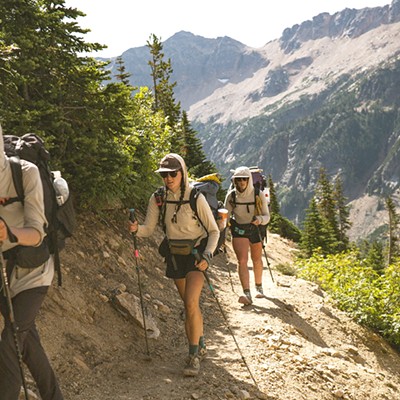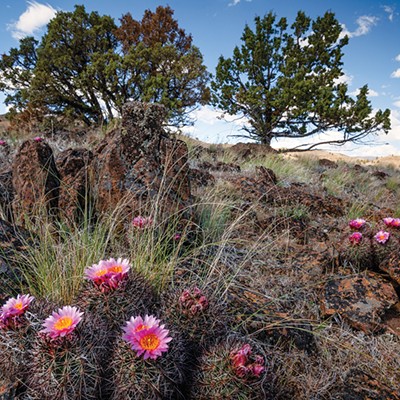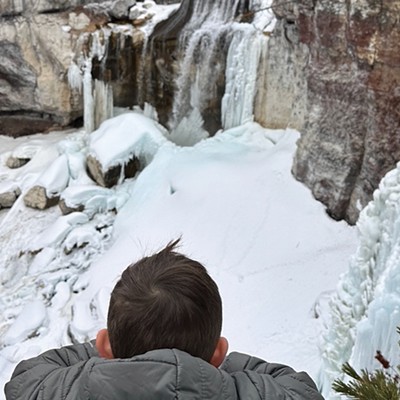"The fact that this nine-mile snowmobile access road is the only in and out is a pretty significant safety issue here," says our guide Ross Duncan over the rumbling engine noise of the snow cat as we travel further and further away from paved road and deeper into backcountry. "From that sno-park it's about 100 miles to the nearest hospital." Food for thought that, for some, would probably be a solid reason to stay home. But for the eight of us and our three guides, it's why we're here, fresh tracks in the middle of nowhere.
My morning started five hours ago in Bend with a 3 a.m. alarm, immediately followed by a prompt smack of the snooze button. There aren't a lot of things that can get me to wake up at an hour that I once considered a bedtime. But in the last 24 hours about 2 feet of fresh snow has fallen on Mt. Bailey, two hours south of Bend and just north of Crater Lake, near Diamond Lake resort.
After a long drive into increasingly treacherous road conditions, I arrive at the Diamond Lake Lodge shortly after 6 a.m. When I walk into the dimly lit lodge, a burly mustached man in his early 50's introduces himself as Oz, the lead guide. He has the frame and friendly demeanor that you might imagine for a real-life Yukon Cornelius. With him is another guide, Ross Duncan. A thin, long-haired, man in his early 40's, Duncan looks every bit as though he just stepped out of a ski movie. By 7:30 the rest of the group has arrived and we jump in a van and drive to Three Lakes Sno-park where we board the snow cat.
For close to 35 years there's been snow cat skiing at Mt Bailey, and lead guide, Rick 'Oz' Oswald has been there for 32 of them. The company runs out of Diamond Lake Resort and is one of the oldest snow cat skiing operations in the country. According to Oswald, cat ski operations started in 1979 with a proposal to open a lift-accessible ski resort. Initially, the snow cat was used to take potential investors out to tour the 6,000 acres of the proposed resort, and ski some of the gentler slopes. While the proposal for a resort remained on the table, when Oswald joined the company in 1981, Cat Ski Mt Bailey had begun to gear toward the backcountry ski experience and the steeper pitches on the mountain. Oswald cites the remote location of Mt Bailey as one of the leading reasons why the resort proposal never got off the ground. He's also quick to joke, "We were just a few ski bums trying to put in a ski area."
"This is a mountain that has very serious consequences if there [are] avalanches," Duncan says as he explains how to use our avalanche beacons. Just after 8:30 a.m. the tank-like treads of the snow cat stop at the end of the snowmobile road. Now at the base of Mt. Bailey, we unload the cat for a brief pit-stop to test the beacons. Should someone be buried in a slide, the rest of the group can use the beacons to quickly locate him or her. We reload the cat; Ross's beacon beeps rapidly as we pass by him confirming they are all working. The cat rumbles back into gear to start the 2,500 foot climb up a four-mile road to where we will be skiing.
{youtube}gfSsewcBX74{/youtube}As the cat lumbers up the mountain at a steady pace, the pitch increases. Ross gives our group a 10-minute warning to start gearing up. The grade of incline is now so steep it feels almost like a rollercoaster clicking its way toward the apex of the track. Suddenly the cat lurches forward over what feels like a ridge. It's hard to see through the condensation covered windows and falling snow. The angle shifts downward, and then flattens out as the cat stops. The calm inside the cabin is broken when the door opens and the wind howls in. We're at 8,000 feet, 363 feet from the summit. It's too windy today to go all the way up, so the guides have a 'storm day' plan on the North Face of Bailey.
The group straps into snowboards or clicks into ski bindings. Oz shouts over the wind. "It won't be as bad further down. Let's go." We drop off the windblown ridge into pristine knee-deep powder. The top is a gentle sloping alpine meadow that works its way to the steep sections of the north face. The hoots and hollers start almost instantly as our pack cruises down the hill, each on our own fresh line. As soon as we start to descend into protected terrain, the wind begins to die down and visibility improves. Oz stops at a quiet wooded spot. Once we've all gathered, he reviews the one at a time procedure on steeper more avalanche prone terrain. One of the other guides makes a ski cut across the slope checking for any avalanche potential. Then, one by one, we carve lines through a steeper gladed section.
One by one, shouts of joy spring from the woods. We gather at the bottom. Derek McReavy, a skier from Nevada, shouts, "That was the best run of my life!" as he rejoins the group. He would go on to say that after each of the seven runs we packed in. Each time adding, "No, seriously that one was."
Later in the day, as we stand at the top of one of the days steepest pitches, Derek's friend, Mark Thorpe, who'd been on a Bailey trip before, shared with the group. "You know, it was so good last time that I was afraid to come back, but it's even better." In one of the cat rides back up, the Nevada resident tells me that he found out about Mt. Bailey from his dentist. His dentist, who'd also been heli-skiing in Alaska, told him Mt. Bailey was just as good and less expensive, so Mark and his friends came up to give it a try.
At $350 per day, it's far from cheap. But if you ask any of the eight in our group, they'll tell you it's worth every penny. Cat Ski Mt. Bailey also offers substantial group discounts if you rent out the whole cat.
Ross and Oz credit the variety of terrain and 360-degree mountain access for their ability to be able to run trips in all weather. With 6,000 acres available through the Forest Service's special use permit, the guides have a lot of area from which to choose. Mt. Bachelor, by comparison, sits on 3,683 acres. So don't expect a weather cancelation. They said they've only had to cancel two trips all season.
Mt. Bailey's not for the faint of heart. Many of the slopes have sections with 40 to 45 degree pitches. By way of comparison, Bachelor's summit bowl is listed at around 42 degrees. You have to have experience riding deep powder and be comfortable in steep terrain. Like their website says, trips are geared toward advanced and expert skiers and snowboarders. Oz and Co. advise that you, "leave the intermediates at home, please!"
On a day when most of Mt. Bachelor was closed, we proceeded to runs on a mountain all to ourselves with each pitch steeper and more challenging than the last. It's no wonder that Oz has been guiding here for so long. For him it's simple, "In the 32 years I've been here, there's never really been two days that were the same."
Now if a 3 a.m. start time isn't your thing, there are a number of lodging opportunities at Diamond Lake resort and also at nearby motels by the Diamond Lake Junction on Highway 97. Cat ski season typically runs from mid-December to late April. Ross says that they still have great conditions into late April even after business starts to taper off, meaning there are plenty of open spots and powder shots available.






















